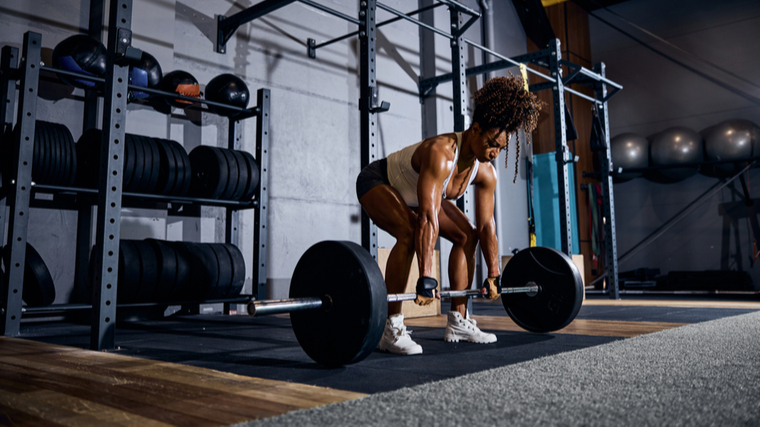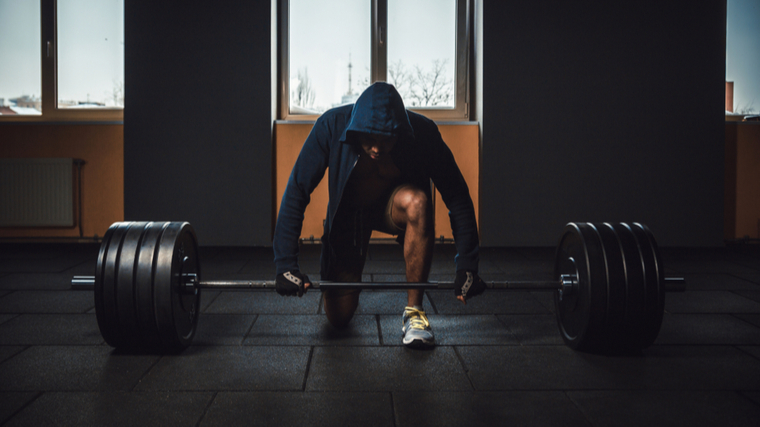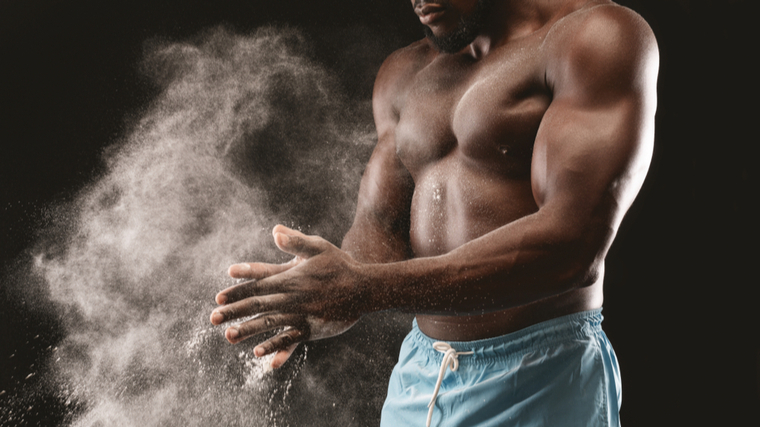Get Stronger and More Powerful With Post-Activation Potentiation (original) (raw)
In the world of fitness, the next big thing is always on the horizon, just waiting to unlock your hidden potential. Those trendy “one cool trick” tactics usually don’t pan out to any real gains, though. Chances are, if something advertises itself as a quick fix, it’ll eventually fade off into the sunset until the next attention-grabbing technique pops up.
If you’re wary of catch-all training strategies that seem too good to be true, you might be hesitant about post-activation potentiation (PAP). But you may want to pause before dismissing PAP as a fad because of its fancy-sounding name. It’s been used for quite some time within the sports performance training realm.

Credit: YAKOBCHUK VIACHESLAV / Shutterstock
PAP can provide a pretty solid improvement to explosive performance and help you get stronger. With this training method, you’ll perform a back-to-back sets of a heavy strength move followed by a plyometric exercise. The goal is to maximize your body’s ability to generate power. And even if you’re not primarily a power-based athlete, you’re likely to find yourself getting stronger along the way.
- **What is Post-Activation Potentiation?
- Post-Activation Potentiation Sets and Reps
- Programming Post-Activation Potentiation
- Benefits of Post-Activation Potentiation
- Who Should Use Post-Activation Potentiation
- Frequently Asked Questions
Even though its name sounds fancy and complex, the principle of PAP is pretty simple. You’ll do back-to-back sets of a heavy strength-based lift paired with an explosive plyometric move. The first exercise gets your body ready to go for your ballistic second movement. You’ll pair exercises that use similar movement patterns — think, squats and box jumps. Your body’s response to the first exercise helps you go harder in the second. (1)
PAP relies on the fact that your muscles and nervous system can be primed or pre-loaded to perform well. Think about it this way: lifting 90 percent of your max and then dropping the weight to 75 percent can make your second set feel as easy as a warm-up. Why? Because your body was ready to go all out again, and instead got to channel all that potential force into a lighter weight. A similar principle applies with PAP.

Credit: Oleksandr Byrka / Shutterstock
In this way, performing a heavy strength move prior to a high-intensity explosive exercise can help your muscles generate power more effectively. (1)(2) PAP may also boost performance by improving muscle temperature, muscle-tendon stiffness, cognitive involvement, and technical or proprioceptive awareness. (1)
Post-Activation Potentiation Sets and Reps
Gradually integrate PAP into your program instead of layering everything in all at once. Start by using PAP with one strength move once per week, and build up slowly from there. Before you begin each session, thoroughly warm up and complete your ramp-up sets.
- Squat-Focused: Back Squat x 3 reps, 85% one-rep max (1RM). 15-second rest. Box Jump x 5. 4-minute rest.
- **Bench Press-Focused: Bench Press x 4 reps, 80% 1RM. 15-second rest. Plyometric Push-Up x 5. 4 minute rest.
- Deadlift-Focused: Deadlift x 3 reps, 85% 1RM. 15-second rest. Double Kettlebell Swing x 8. 4-minute rest.
- Overhead Press-Focused: Overhead Press x 4 reps, 80% 1RM. 15-second rest. Wall Ball x 5. 4-minute rest.
Make sure you’re doing exercises you’re very familiar with so your body can focus on generating power rather than learning new exercises. For example, if a PAP protocol calls for box jumps but you haven’t mastered them yet, consider substituting them with jumping lunges.
Programming Post-Activation Potentiation
While post-activation potentiation can be an extremely useful tool, it is a rather intense one. You want to make sure you’re giving your body enough time to recover effectively. How you integrate PAP into your program depends on several factors, including your goals, your regularly-scheduled exercises, and your absolute strength.
Goal
Training for maximal strength or power output benefits the most from PAP. Some benefits of PAP, like improved cognitive involvement or muscle-tendon stiffness, may be applicable to all forms of your training. But the true performance-enhancing benefits of PAP are found in strength or power workouts. In times of intense training or peaking, PAP can be the technique that helps you realize your truest potential.
Exercise Selection
Choosing the right exercises to use PAP with is also an important decision that affects how often you’ll be using the technique. Heavy compound exercises — such as squats — paired with sprints, jumps, or other plyometric moves are some of the best ways to use PAP. With that in mind, you can only perform these exercises with so much frequency within a program to maximize recovery. This will be dictated by how often you squat, jump, or sprint.
You’ll want to pair exercises that follow the same movement patterns. For example, put bench presses with plyometric push-ups or deadlifts with kettlebell swings. This way, you’ll be priming the right muscles for maximum engagement in your explosive round of work.
Absolute Strength
Training for absolute strength generally reduces your training frequency so you’re not crushed by overwhelming load or volume too often. Especially when paired with the performance-enhancing effects of PAP, doing heavy lifts or explosive exercises with increased frequency can easily take a toll on your recovery.

Credit: Prostock-studio / Shutterstock
Say you’ve chosen to integrate PAP into your squat sessions. If you’re squatting two or three times per week, start integrating PAP once a week until your body gets used to it. Then, integrate it into your second squat session and see how your body responds. If you’re able to recover adequately, consider adding it to your third session, too — but only if your body can handle the added toll.
Diminishing Returns
As with any training technique, your body will adapt to what you throw at it. The physiological effects of PAP itself may still be working, but at some point max intensity gets too draining. Your workouts may be more fun at first, but pay attention to when you’re overwhelmingly bored and your progress has stalled.
Spreading out PAP throughout a periodized program can help you maximize your performance and minimize your fatigue. Cycling PAP training in and out every four to six weeks can be a good starting point for many lifters to avoid both overtraining and plateaus.
Benefits of Post-Activation Potentiation
Working PAP-style training into your sessions can give your body the boost it needs to crank out some more effective plyometric reps. When used correctly, you can use this particular brand of lifting to help you train and perform much more optimally for your strength or power sessions.
Easy to Program
In a sports performance context, programming PAP while you’re peaking makes a ton of sense. PAP can help you achieve maximal output for your chosen exercise. Therefore, you would want to be utilizing it when your loads or intensity are at their highest.
Even if you’re not training for competition, programming PAP into your routine is a great way to save time without sacrificing strength. For example, arranging your workout around similar patterns and using one heavy variation before a more explosive muscle-building selection can help you optimize your performance across many different goals. You can do this by performing plyometric push-ups after a heavy bench press set. You’ll save time while being able to build toward strength and muscle all at once.
Easy to Execute
PAP doesn’t have to be overly complicated. In fact, it’s most effective when you select exercises that you’re already familiar with. For example, if you’re accustomed to performing both squats and box jumps, you can pair them back-to-back with PAP. They won’t feel easy to do — this is a high intensity form of training — but you’ll be familiar with the techniques to stay safe.
Enhanced Performance
PAP has been shown to have some pretty immediate and impressive benefits to your performance. (1) You can get a lot more bang from your buck from the second exercise — the explosive one — if you perform a strength move first. (2)

Credit: TORWAISTUDIO / Shutterstock
[Read More:_** **_Powerbuilding Workout Routin e, With Tips from a CPT ]
The entire allure to it is that the technique can be seamlessly woven into your warm-ups or paired with your preferred exercise without much modification to the rest of your workout. In this way, you don’t have to sacrifice your strength moves on days you want to train power.
Who Should Use Post-Activation Potentiation
While PAP may sound like a tool exclusively for performance athletes, it can absolutely be implemented into the program of strength athletes and everyday lifters alike.
Explosive Athletes
Explosive athletes — whose sports require them to generate a lot of force very quickly — use PAP perhaps most often. If you’re a sprinter, jumper, thrower, or use any number of plyometric-type exercises — CrossFit, anyone? — you likely will benefit from using PAP to prime your system. After a heavy set of exercises, it’s a lot easier to reach absolute peak explosive power during those box jumps or kipping pull-ups.
Strength Athletes
While classically used for explosive benefits, you can also use PAP to improve your absolute strength output, as well. Power is how much force you can produce quickly, while strength is how much force you can produce absolutely. Strength athletes like Olympic lifters are constantly training to strike a balance between these two factors (along with technique). Because PAP ensures a mix between heavy lifts and powerful ones in your training, it can work especially well for training Olympic lifts.
Recreational Gymgoers
PAP is not just beneficial for competitive strength or power athletes. If you’re just looking to improve your technique or add some pounds to the bar on any given day, PAP can help you train closer to your potential no matter who you are. The same benefits from the protocol can transfer to barbell exercises, plyometrics, or machine-based moves depending on your goals and programming.
Wrap-Up
Post-activation potentiation truly is one of the coolest “tricks” out there in the world of weight training — and it’s not just all talk. By simply performing a heavy compound lift followed by an explosive move, you can peak your performance within each session.
Although it is generally considered a sports performance training technique, you can use post-activation potentiation to enhance strength-focused goals, too. Just pick an exercise pattern to match together and allow the PAP effect to improve the quality, intensity, and results of your training.
FAQS
Still got questions about what the heck post-activation potentiation is, and how you’re supposed to use it? No worries. We’ve got answers.
What are the best exercises to use with post-activation potentiation?
The best exercises for PAP benefits tend to be heavy compound strength lifts and plyometric moves. You can pair exercises like heavy squats followed by plyometric jumps or overhead presses followed by wall balls. Make sure your exercise pairings are using the same muscle groups and movement patterns to maximize results.
What are the best set and repetition schemes to use with post-activation potentiation?
PAP calls for maximum or near-maximum loading or efforts to drive the benefits you’d be looking for in the performance exercise afterwards. This means that your set and repetition scheme will likely be a single set in a high — above 80 percent — of your 1RM loading percentage. Perform your second PAP exercise using anywhere from 60 to 85 percent of your 1RM for weighted lifts, or a moderate intensity and five to eight rep range for bodyweight moves. (3)
Is post-activation potentiation safe?
As long as you are using exercises you know how to do and are listening to your body’s cues, PAP doesn’t necessarily pose a higher risk of injury than other forms of high-intensity or pre-exhaust training. You can (and should) always scale your workout to your personal strength and exercise capabilities. There is no need to choose an exercise that you’re uncomfortable with, and you’ll keep the loading within ranges you use in your regular training.
References
- Blazevich, A. J., & Babault, N. (2019). Post-activation Potentiation Versus Post-activation Performance Enhancement in Humans: Historical Perspective, Underlying Mechanisms, and Current Issues. Frontiers in physiology, 10, 1359.
- Seitz, L. B., & Haff, G. G. (2016). Factors Modulating Post-Activation Potentiation of Jump, Sprint, Throw, and Upper-Body Ballistic Performances: A Systematic Review with Meta-Analysis. Sports medicine (Auckland, N.Z.), 46(2), 231–240.
- McGowan, C. J., Pyne, D. B., Thompson, K. G., & Rattray, B. (2015). Warm-Up Strategies for Sport and Exercise: Mechanisms and Applications. Sports medicine (Auckland, N.Z.), 45(11), 1523–1546.
Featured Image: YAKOBCHUK VIACHESLAV / Shutterstock